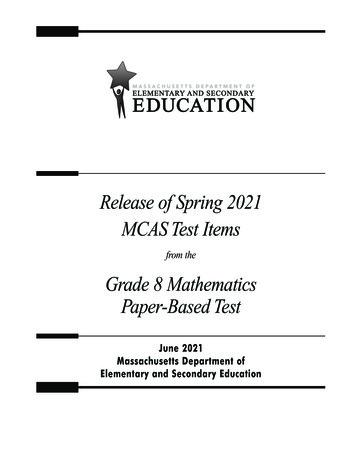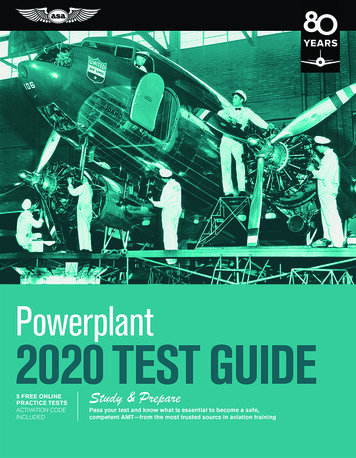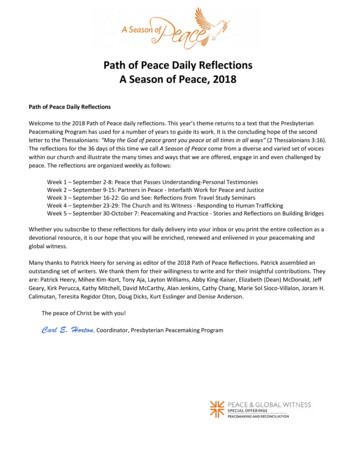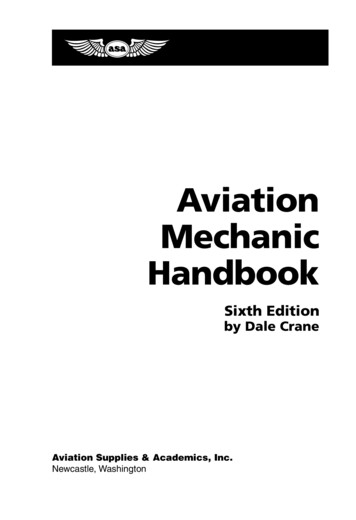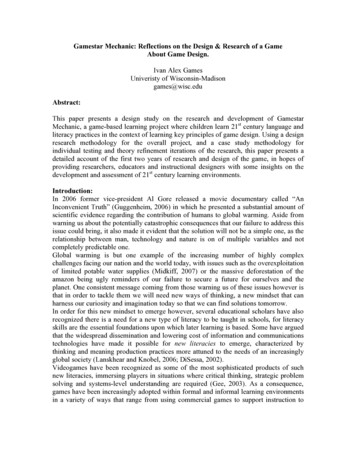
Transcription
Gamestar Mechanic: Reflections on the Design & Research of a GameAbout Game Design.Ivan Alex GamesUniveristy of Wisconsin-Madisongames@wisc.eduAbstract:This paper presents a design study on the research and development of GamestarMechanic, a game-based learning project where children learn 21st century language andliteracy practices in the context of learning key principles of game design. Using a designresearch methodology for the overall project, and a case study methodology forindividual testing and theory refinement iterations of the research, this paper presents adetailed account of the first two years of research and design of the game, in hopes ofproviding researchers, educators and instructional designers with some insights on thedevelopment and assessment of 21st century learning environments.Introduction:In 2006 former vice-president Al Gore released a movie documentary called “AnInconvenient Truth” (Guggenheim, 2006) in which he presented a substantial amount ofscientific evidence regarding the contribution of humans to global warming. Aside fromwarning us about the potentially catastrophic consequences that our failure to address thisissue could bring, it also made it evident that the solution will not be a simple one, as therelationship between man, technology and nature is on of multiple variables and notcompletely predictable one.Global warming is but one example of the increasing number of highly complexchallenges facing our nation and the world today, with issues such as the overexploitationof limited potable water supplies (Midkiff, 2007) or the massive deforestation of theamazon being ugly reminders of our failure to secure a future for ourselves and theplanet. One consistent message coming from those warning us of these issues however isthat in order to tackle them we will need new ways of thinking, a new mindset that canharness our curiosity and imagination today so that we can find solutions tomorrow.In order for this new mindset to emerge however, several educational scholars have alsorecognized there is a need for a new type of literacy to be taught in schools, for literacyskills are the essential foundations upon which later learning is based. Some have arguedthat the widespread dissemination and lowering cost of information and communicationstechnologies have made it possible for new literacies to emerge, characterized bythinking and meaning production practices more attuned to the needs of an increasinglyglobal society (Lanskhear and Knobel, 2006; DiSessa, 2002).Videogames have been recognized as some of the most sophisticated products of suchnew literacies, immersing players in situations where critical thinking, strategic problemsolving and systems-level understanding are required (Gee, 2003). As a consequence,games have been increasingly adopted within formal and informal learning environmentsin a variety of ways that range from using commercial games to support instruction to
designing games specifically tailored to instructional goals (Games, Learning andSociety, 2005).This paper presents a design study of the first two years of a research project on thedesign and assessment of Gamestar Mechanic, an online multiplayer role-playing gamedesigned to foster middle school children’s 21st century language and literacy skills, byteaching key principles of game design (Games and Squire, 2008; Salen, 2007).The Gamestar Mechanic project is a collaborative research and development effortbetween the Games, Learning and Society Group at the University of Wisconsin-Madisonand Gamelab, a professional game design studio based in New York. The development ofthe game has been funded by the John D. and Catherine T. Macarthur Foundation’sDigital Media Initiative, an effort to promote research that deepens our understanding ofthe ways in which digital technologies are impacting the social, civic and academic livesof today’s youth.The game is set within a narrative that places players in the role of game mechanics in afantasy world where games provide the fundamental energy on which life is sustained. Inthe game narrative however, disaster has struck and the once working system upon whichthe world function has fallen to disrepair. As they advance towards restoring harmony tothe world, players also move towards membership in an elite organization called theCouncil of Master Mechanics, some of which are represented by game characters butwhich can also be impersonated by live players. To do so, they must complete a series ofjobs that involve playing, designing, documenting and repairing games, as well asdiscussing their games and having them rated and critiqued by others.To complete these jobs, mechanics must collect a series of sprites (e.g. heroes andenemies), creatures pre-designed with specific qualities and behaviors. A mechanic’ssprites are stored within his/her toolbox (see figure 1), a web-based game editor wheresprites can be dragged from a palette into a play area, and combined into new games.Figure 1: Completing a Job with the Gamestar Mechanic Toolbox.A fundamental aspect that the game exploits in order to foster the appropriation of agame designer Discourse by learners is framing these jobs in the context of a robust
community of mechanics with a variety of levels of expertise in game design. In additionto the game narrative, the game supports the emergence of such a community throughseveral in-game facilities (see Table 1) that together provide the framework upon whichthe Gamestar Mechanic experience rests.Table 1: Gamestar Mechanic Discourse facilitation features.ToolDescriptionThis profile page provides players with an organizational framework to track the gamesand jobs that thy have completed or need to complete. It also provides others with a placeWorkshop to identify a specific mechanic’s game design interests and preferences through acharacter profile, as well as his/her relative status in the community in the form of anexperience level and the ratings for the games he/she has created.In this toolbox the player can access the collection of sprites available to him/her sofar, and use them to design new games. This toolbox also serves as the context withinToolboxwhich factory jobs will be tackled whether their goal is to play, fix or design gamesfrom scratch.The factory is the central metaphor for the fantasy world of Gamestar Mechanic. In it,players begin the game with most areas covered with steam and very few jobsFactoryavailable for them to work on. As they successfully complete jobs, the game thenupdates the state of the world, more jobs become available in the map, and new areasof the factory accessible, as the steam recedes from them.The game alley provides the public arena where the true “value” of a game can betested. Games that are published by designers in their toolbox become available to playGame Alley by others in this area. When a published games is played, a rating scale and a form toprovide comments are associated to it on the website.Having been a core member of the Gamestar Mechanic team for the last two years hasbeen a rewarding experience, and one of personal growth for me in many ways. Thus, inpresenting this account of our research and design process, my aim is twofold: first, tocontribute to the literature on games and learning by presenting researchers andpractitioners with my insights and those of other team members regarding a novel way toapproach literacy instruction in the classroom. Second, I hope that by sharing the lessonslearned in this project I can provide instructional designers contemplating thedevelopment of videogames for learning with useful insights for their own designs.Theoretical Framework:Since its inception the design, implementation and assessment of Gamestar Mechanichave relied on the socio-cultural theoretical framework that informs much of the recenttheories on games and learning (Gee, 2003; Steinkuehler, 2006; Squire, 2006; Shaffer,2006). This theoretical perspective conceives knowledge as a function of the interactions
between individuals, the social groups they belong to, and the material context thatsurrounds them. This body of research includes a diversity of scholarly work commonlyassociated with social constructivist perspectives of learning (Vygotsky, 1978) including(but not limited to) activity theory (Emgestrom, Miettinen and Punamaki, 1999), situatedlearning (Lave, 1993; Lave and Wenger, 1991), mediated action (Werstch, 1991),connectionism (Bechtel and Abrahamsen, 1990), socially embodied cognition (Barsalou,Niendenthal, Barbey and Rupert, 2003), distributed cognition (Hutchins, 1995),ecological psychology (Gibson, 1977), Discourse theory (Gee, 1992; 1996; 2005), andsociocultural theories of literacy (New London Group, 1996).As a design experiment, the game is engineered to be a reification of theory as much as avehicle for its testing and refinement. As such, the goal for the Gamestar Mechanic teamhas been to produce a learning environment that encourage the appropriation of what Geerefers to as the big “D” Discourse of game designers (1996). By discourse, he refers to an“identity toolkit” represented by the ways of doing, communicating, thinking, andinteracting with the material world that people use to demarcate an identity as membersof a particular community to others (in this case, an identity as game designers).It is important to mention that while Gamestar Mechanic is a game about game design, itspurpose as a learning tool is not to train professional game designers. Rather, byimmersing students in key activities of game design, it is intended to be an epistemicgame (Shaffer, 2006) that encourages learners to think like game designers do. Accordingto Gee (2007) “In epistemic games, learners do things that have meaning to them and tosociety. Such games are knowledge games. They are meant to teach learners both how tonavigate complex linguistic, cognitive, and symbolic domains and to innovate”.While an increasing number of such communities are becoming available online in sitessuch as kongregate , gamebrix and sploder , a core difference with GamestarMechanic is that the community is framed in the context of a role-playing game. Thepurpose of this is to take advantage of the potential that games have in terms ofencouraging players to “try on” virtual identities, in this case a game designer identity(Gee, 2003 P. 48).Methods:Aside from a game, Gamestar Mechanic is also an experiment in engineering a pedagogycentered on game design. As with similar experiments the main methodology that theGamestar Mechanic team has followed throughout these years to document the learningthat takes place in this context has been Design Research (Brown, cite; Collins, cite).Design research (also referred to as design experiments) is a methodology aimed atiteratively developing and refining theory regarding innovative educational interventionsin authentic settings. At the same time, it aims to reify the refined theory in subsequentredesigns of the intervention itself, allowing researcher new opportunities to test it.Through these iterations of design-hypothesis testing-redesign, its objective then is togradually develop an understanding of the overall ecology of the intervention, itscomponents, and systemic relationships (Cobb, et al. 2003). Gamestar Mechanic is also ateaching experiment (Cobb, 2000) for the role of the researchers has been in many casesto manipulate the context to achieve the desired learning goals for the students. Whileskeptics might claim that such interventions “taint’ the research context and diminish its
validity, we subscribe to Cobb’s argument that effective instructional methods develop asa result of such goal-oriented manipulation, and better theories of instruction result.Data Collection: An integral part of the design studies is keeping a systematic record ofthe observations done during the different research iterations, so as to be able to provide adetailed and credible account of the changes that took place between them. The datasources for this study were collected by members of Gamestar Mechanic research teamduring the two years of research, and included transcripts of interviews with players andmembers of the Gamestar Mechanic team, naturalistic and participant observations, fieldnotes, audio and video recordings, as well as digital and paper-based documents.Data Analysis: In this paper I provide an account of the design and research process forGamestar Mechanic. Each cycle of the research involved sometimes the same, sometimesslightly different contexts and groups of participants as required for testing our evolvingtheoretical questions. For this reason I decided to treat each cycle as a separate case usingcase study methodology (Stake, 1995) to describe the components, goals, settings,outcomes and lessons learned from it. I present each case using an ethnographicmethodology (Geertz, 1983) focused on presenting a “thick description” of the events,participants and material context involved.The cases represent three cycles of research and implementation that have taken placeover the life of the project. In their respective sections, I provide detailed descriptions ofthe relevant participants, context and data sources. I coded the data collected from thedifferent sources according to the framework proposed by Collins, Joseph and Bielazyc(2004). In order to verify the trustworthiness of the constructs identified, I submitted thedata for verification and joint analysis by other members of the Gamestar Mechanic team,in addition to relying on the multiple data sources generated in each phase to triangulatemy interpretation of these constructs.Limitations of the Study: One of the central limitations of using the design researchapproach is that it generates “humble” theories (Cobb, et al. 2003) that are specific to theparticular design and context for the study. Such theories necessarily forfeit any claims togrand generalization. In this case, an aspect that could be perceived as a possiblelimitation to this research is the fact that while the objective of the game is to promote thethinking practices of game designers on young learners, the fact that the game has beendesigned by Gamelab necessarily implies that the practices promoted will be those ofsome game designers. While this is certainly an issue if one wants to make an argumentfor large-scale generalizability, the Gamestar Mechanic team members see it also asstrength. Given the wide variety of approaches and styles that different designers bringinto their own design process, it can be confusing and difficult for new learners to cometo understand the nuance and complexity of their Discourse. The structure providedteaching a specific approach to design can provide a scaffold for these learners a point ofreference from which they can think critically about other approaches they learn in thefuture. Nevertheless I caution against extrapolating too far on these observations.One final limitation of the study is that some of the student samples used for the researchhave been convenience samples. Given theFieldwork: The Design and Assessment of Gamestar MechanicIn this section I present an account of the first two years of design and research ofGamestar Mechanic. I organize the narrative according to the two stages of design and
implementation that have concluded at the time of writing. Being a product of designresearch, Gamestar Mechanic is not only meant to inform learning theory development,but also to be a reification of such theory at different stages of its evolution. Forconsistency with the language used in the data and description, I found it useful to labelthe three cycles according to the widespread (some would even say standard)nomenclature used to identify different stages of the software release lifecycle (SoftwareRelease Lifecycle, 2008): pre-alpha, and alpha. These labels refer to the degree in whichthe features of a software product have been successfully implemented and tested withinit, with pre-alpha representing a basic prototype and alpha typically representing aproduct where most core features are implemented, but where those core features maystill undergo changes.Cycle 1 - The Pre-Alpha Phase:Research into the learning potential of the game formally began during the Fall of 2006, atime during which the Madison and New York members of the Gamestar Mechanic teamconducted extensive reviews of the literature and software associated with existinginterventions involving game design for learning (Hayes and Games, 2008), with thepurpose of informing the initial design strategy for Gamestar Mechanic. Advised by theresearchers in Wisconsin, the Gamelab designers engaged an intense process of researchand creative production involving initial versions of the look and feel for the gameinterface, the narrative and the play experience, all of which were documented digitally ina design document and a shared wiki site. The outcome of this process was that byNovember of that year, an initial prototype of the game was available for testing. Twoinstances of prototype testing took place in Madison between the late Fall semester of2006 and the early Spring of 2007, described in the following sections:Elements and Goals of the Prototype: The prototype consisted of a) an early version ofthe toolbox with a limited set of sprites and fixed behaviors, b) paper based sprite profilesthat would allow the players to compare sprite descriptions and make decisions as towhich to use in their games, c) a rudimentary version of the game design curriculumwithin the narrative and jobs in the form of paper-based narrative storyboards, and d) agame label format where players would write the description and instructions for theirgames. Table 2 shows an example of each of these components. Their purpose was tosimulate as completely as possible the overall experience of playing Gamestar Mechanic.Because the game in meant to be a reification of learning theory, this prototype wouldallow us to conduct initial empirical tests of some key theoretical questions.Test 1 Settings and Documentation Methods: The first test of the prototype took place intwo over two days in December 2006 at a computer lab in the University of WisconsinMadison. We recruited the participants from the general community through flyersannouncing a mini game design workshop for children. The participants were sixteenchildren ranging in age from 6th to 8th grade from diverse ethnic backgrounds includingAfrican-American, Hispanic, Asian American, and Caucasian, and there were slightlymore males than females. Before beginning the workshop, we conducted a series ofinformal interviews with them on their gaming preferences and history, we found that allhad played games before, and at least half considered themselves “gamers.” Only two
responded that they had made a game before, and in both cases they said these wereboard games made as part of a school assignment.At this point in the research one of our core questions was whether the game would beinteresting and engaging to them. Current games and learning theory tells us that welldesigned games promote extended engagement by the players, and that this engagementis a crucial component in promoting player adoption of the identities proposed in them(Gee, 2003) As a consequence, a goal of simulating the overall Gamestar Mechanicexperience was for us to assess whether the core learning activities within it would fostersuch engagement, for otherwise we would have to rethink our approach to designaltogether. We also had questions regarding the steepness of the learning curve thatchildren would experience trying to play the game, especially given that some of theprototype’s functions had not been thoroughly tested yet.Table 2: Components of the Gamestar Mechanic Prototype.a) Toolboxb) Sprite Profilec) Narrative Storyboardd) Game Label FormWe tested for these questions in two ways. First, we wanted to test the participants’
responses to the individual aspects of the design curriculum within the game. Pairs ofchildren played the game mediated by a designer in a small room with a one-way mirror.The designer followed a protocol that simulated the prompts and dialogues that thenarrative and characters in the complete version of the game would present to players.This protocol asked players to tackle both structured and open-ended design jobs, the firstones requiring the player to directly designing games on two computers. During thesession, the designer to simulate the kind of in-game prompts and dialogues that will bepresent in the final version of the game, and the kids worked both with structuredchallenges and in open play where they could design games from scratch. These sessionswere video recorded, and members of the Gamestar Mechanic team observed andcollected field notes from behind the one-way mirror.Second, we were interested in their responses in the context of the community-basedactivities of the game, sharing, rating and making games for others. To test this, I gavechildren a quick presentation introducing the narrative of the game, and a demo on usingthe toolbox to make a simple game. We then asked children to go play in a computer labwith ten computers, where I gave them the rules for a job that required making games forothers to play test, and fix them using any feedback obtained from their peers.In order to garner some initial insights regarding their engagement with the game, wealso gave them access to a video game lab where they could play many popular gamessuch as Guitar Hero and Halo.Test 1 Outcomes: While our observations on this initial test were preliminary and tooearly to reach any conclusions, they were encouraging as well. Even after hours ofplaying with the game and having the option always open to go play other games (whichthey took on several occasions), most of them kept coming back and trying new designswith the toolbox prototype during the 6 hours that the session lasted. It was alsoencouraging to see the speed at which the children were able to pick up the editor andbegin designing. It was also noticeable that the social jobs were effective ways to engagethe players with design, the boys tended to enjoy first designing complete games to sharewith friends more rapidly than girls. The designs themselves however would commonlyuse a shooting the enemy mechanic and tended to be more simplistic. Girls in contrasttended to design in groups, with one girl controlling the mouse while others commentedand made suggestions to her. The designs took longer to make, but were more complex intheir use of space and used a variety of mechanics such as collecting coins or navigating amaze.This test also initially hinted at the ways in which students might initially conceive termsfrom the specialist language of games. As they designed or tested games, I would walkaround the room and ask them if they thought the game they were making or playing wasgood. Several of them responded in function of the difficulty, with statements such as“this game is too easy” or “this game is cool cause it’s super difficult!” typifying theirresponses. One final interesting observation was that about half the students preferreddesigning games on their own, while the other half preferred to do it socially hinting atthe possibility that we would have to implement multiple paths to advance in the game tokeep players engaged.Test 1 lessons learned: This test however, also hinted at some limitations of the gamemodel we had not expected. Even though the editor was designed with the intention ofletting children test out individual creatures and iteratively improve their games, we
noticed that the majority of them would take at least 15 minutes designing a game beforetesting it even the first time, leaving questions open as to what degree of understanding ofindividual components of their games they could get from the game. One of the ways thatthe initial prototype aimed to encourage this was by letting players modify (mod)previously designed games, however most of the time students seemed to prefer erasingall the creatures on the screen and starting new games of their own from scratch.In this initial prototype, the game design jobs consisted of games that could be played ina single screen of the game. During the test however, several of the players askedwhether they could create games with multiple levels, a function not implemented in thetoolkit at that point. This limitation however, became an opportunity for us to observe theway in which players could work around the limitations of the game to make their designintentions happen, as instead of creating a single game with multiple levels, they createdmultiple games representing different levels of difficulty of the same concept using thename of the game, and presented them to their peers this way.One question that remained unanswered at this point was the degree to which childrenwould appropriate the specialist language of game designers, a crucial component inenacting their Discourse. From the observations done in this initial test there was verylittle to suggest that the children were using the language presented in the storyboards orthe creature profiles to discuss their designs, and it remained an area of interest for furthertesting.Test 2 Setting and Documentation Methods: As a result of our preliminary observationsduring the first test, the Gamestar Mechanic team made the decision to follow-up with amore in-depth set of tests. Even though the preliminary observations suggested thatchildren found the game engaging, the question still remained regarding whether theywould sustain engagement with it over an extended period. We also wanted to knowwhether such engagement would lead to students appropriating more of the practices ofthe Discourse of game design, and whether the curriculum designed for the game wouldfacilitate this appropriation.Observations from our previous test suggested that the game jobs (both social andindvidual) would provide the most promising contexts to answer these questions, sincemost participants’ design took place in this context. In order to structure the workshoparound jobs, I used a set of job templates provided by Gamelab with the prototypestoryboards. These templates were short texts that described the instructions and scope ofthe specific job the children needed to complete. Jobs were organized according to threecategories: a) play jobs –where players needed to win a game previously designed, b)repair jobs –where they had to identify and fix a problem with a dysfunctional game-,and c) design jobs – where they had to design a game from scratch within constraintsspecific to the Discourse. A design label for example would typically look like thefollowing:“A core mechanic represents the essential moment-to-moment activity of the player, what the players willdo over and over as they play. For this challenge, make a game where the core mechanic is to collectthings. When you’re done, write the instructions for your game so that others can play it.”We conducted a second round of tests in Madison, during the Spring of 2007, using anextended workshop format where a group of participants would meet 2 hours a week for8 weeks. The workshop was structured around the jobs, and during each session the
participants would attempt to tackle one to three of them depending on their scope. Tofocus the test on collecting more in-depth participant data as opposed to group level data,only five middle school between the 7th and 9th grade from the Madison, Wisconsin areawere selected for participation. Three of the children were girls and two were boys (who Ihenceforth will refer to with the pseudonyms Ana, Barbara, Carla, David and Edgar), forbut only the two boys and one girl identified themselves as regular gamers.Even with this self-assessment, the amount of experience and play time for the boys wasnearly twice that of the girls in terms of hours/week invested in play. Moreover, one ofthe boys (with the pseudonym David) explained that aside from playing games hewatched the G4 channel (a cable channel dedicated to videogames) for several hours aweek, which was substantially more experience than any other participant.Barbara had a visual impairment that required her to do her work very slowly, butotherwise did not stop her from participating. The girls knew each other and the boysknew each other, but there were no cross gender acquaintances. The children came from avarious socioeconomic backgrounds, and all of them were Caucasian. Attendance to thesessions was voluntary, and during the whole workshop the children had the option ofleaving the computer room and going to the game room to play with the game consoles.During this stage of the research also aimed determine the most effective ways todocument the learning process of players. Given our interest in collecting in-depth dataon their enactment of the game designer Discourse, we chose methods that would captureas fully as possible the interactions between the participants, the toolbox and the jobcontext. One of the main tools people can recruit in order to participate in a Discourse isits set of language practices (Gee, 1996; 1999; 2005). Through language, participantssituate meanings and construct reality for each other and ultimately demarcate an identityas members of a community. In this context, what it means to “know something” is afunction of the interaction between two or more participants; since one can only claim toknow something if someone else is there to validate it (Gee 2005, p. 23).With this in mind I attempted to capture the language practices of participants using bothoral and written samples. I relied on structured and semi-structured interviews Videorecording became very useful for capturing the oral practices, as I conducted recordingsof th
It is important to mention that while Gamestar Mechanic is a game about game design, its purpose as a learning tool is not to train professional game designers. Rather, by immersing students in key activities of game design, it is intended to be an epistemic game (Shaffer, 2006) that encourages learners to think like game designers do. According
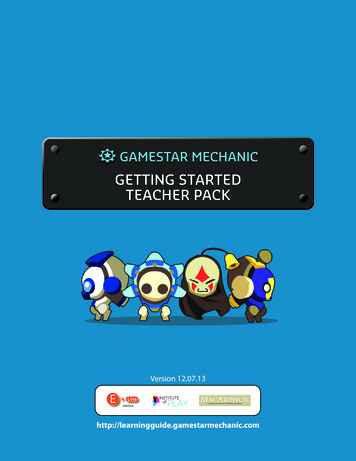




![Motorcycle Mechanic [MM] - CTEVT](/img/5/motorcycle-20-20mechanic-2010.jpg)
